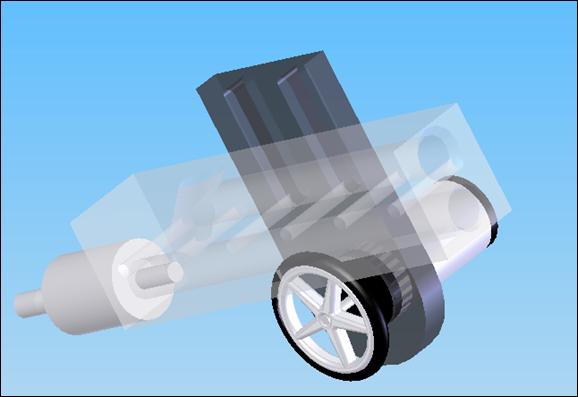
Mechanical


The “Scorched Earth” game is centered around a physical “artillery” assembly. As such, its design contained a strong mechanical component. The various mechanical systems of the game will be broken down below.
The Cannon
For Scorched Earth, we constructed a small launcher that would reliably and accurately shoot half-inch acetal plastic (Delrin) balls at variable velocity. To fit into a fast-moving arcade game, the cannon also had to be semiautomatic.
The body of the cannon was machined from a solid piece of a clear polycarbonate plastic.
The launch tube, or barrel, sits underneath the reload barrel. An angled feed ramp (at 45°) connects the two. The feed barrel has a slot milled into its underside to allow for our pitching flywheel.
The launch tube, feed ramp, and reload tube have all been reamed, with sharp edges broken, for accuracy of launch.

When a ball is loaded into reload tube, it falls into place in the launch tube, on top of the solenoid armature. Any additional balls loaded are trapped in the feed ramp by the ball currently ready to fire.
When the solenoid is pulsed, the plunger shoots forward, shooting the ball forward into a spinning, foam-covered flywheel (our “kick wheel”). Like a pitching machine, this kick wheel is spinning at high speed, driven by a Maxon DC motor at high RPM. This wheel throws the ball out of the barrel, and the speed at which the ball exits is a function of the speed of the wheel, which in turn is controlled by the duty cycle of the PWM signal we are sending to the motor.
As the solenoid retracts, a ball from the feed ramp falls into the launch tube, ready to fire.

The solenoid and Maxon motor are both mounted through the use of threaded holes in the barrel itself and lasercut acrylic attachment flanges. The kick motor attachment flange is slotted so that it can be attached in a variety of orientations to the launch barrel, which was useful during testing.
Elevation Control
To give the operator a second degree of freedom, the entire cannon assembly is attached to an elevation control. The barrel is mounted to a large 5.5” diameter gear. This gear is attached to a hub which mounts to a ½ inch shaft. This shaft in turn rotates on a set of 2 ball bearings mounted in lasercut acrylic pieces.
The movement of the large gear is obtained by using a DC motor with integral gearbox attached to a small gear. The large spur gear has 110 teeth, while the small drive gear has 20 teeth, for a gear reduction of 5.5:1.
With the output of our motor’s gearbox spinning at approximately 30 RPM, our large gears spins at 5.5 RPM, or 30° of elevation per second.
The drive motor is mounted into the same acrylic tower that holds the frontmost bearing for the turning shaft, and is held in place by means of a 4-40 set screw.

Cannon Elevation Mounting Board
To make final construction simpler and to be able to tune our distances to give a reasonable game difficulty, the elevation control / firing mechanism was mounted to a single solid ½” lasercut block. This block had a pattern of holes through which the board was eventually screwed to the game chassis.

Target Sensor / Outfeed Ramp
In distinct contrast to the other mechanical systems built for Scorched Earth, the system to collect, count, and return launched balls was quite simply designed and constructed. Incoming balls were trapped between 2 masonite walls approximately 2 inches apart. These balls were free to fall until the hit the first of 2 ramps. These ramps were very slightly angled (15° and 10° respectively), so that a ball would first bounce on the top rail several times before coming to a roll. The clearance between the bottom ramp and the top ramp was only slightly greater than the diameter of the ball, which allowed only rolling balls to leave this simple trap. Further down this ramp was an optointerrupter, which could count the balls rolling down. The balls then hit a simple outfeed ramp.

SWAG Launcher
Our swag launcher utilized a variation on a common toy: the PEZ dispenser.
We used another geared DC motor, the same as that used to drive the elevation control, attached to a lasercut cam. This cam profile, along with careful motor placement, allowed the 3 prongs to each cycle the PEZ dispenser and shoot out a piece of candy.



Dimensioned Drawings:




